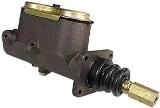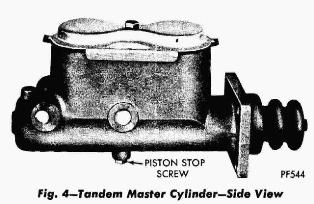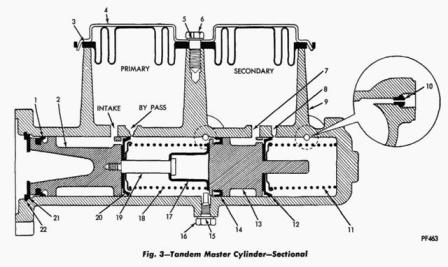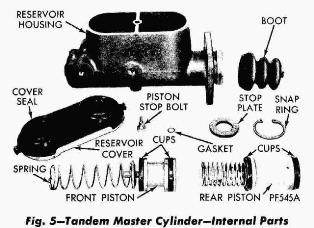GENERAL INFORMATION
The dual master cylinder used with the split hydraulic service brake system on M-375
chassis produced after February 1971 (Fig. 2) is a split-ratio, dual reservoir device
with a 1.75 inch bore. The front piston displaces 40 percent and the rear piston
displaces 60 per cent. The rear outlet is connected to a frame mounted Bendix Hydrovc
unit which is in turn connected to the wheel cylinder on each of the front wheel brake
assemblies and to one wheel cylinder on each of the rear wheel brake assemblies. The
front outlet is connected to a second frame-mounted Bendix Hydrovac unit which is
connected to the other wheel cylinder in each of the rear wheel brake assemblies. If
these components are disconnected for any reason, be careful that the split hydraulic
brake system on the M-375 chassis is reconnected exactly as it was disconnected (Fig. 1,
also see "Brake Hose and Tubing" this Group).
|

|

Figure 1
|

Figure 2
|
SERVICE PROCEDURES
Disassembly
- Loosen shouldered master cylinder cover bolt.
- Lift off reservoir cover and cover seal. Pour out any excess brake fluid and stroke
piston to force residual fluid through outlet ports.
- Remove piston stop bolt and gasket from bottom of reservoir housing (Fig. 3 and 4).
- Remove retainer ring from groove in push-rod end of cylinder bore with snap ring pliers.
- Remove stop plate. All internal parts should slide out of cylinder bore easily. If they
do not, apply rompressed air carefully at front outlet port. If parts do not come out of
bore easily, examine bore carefully for damage which may eliminate the possibility of
reconditioning the master cylinder. If such damage is found, replace the master cylinder.
|

Figure 4
|

Figure 3
LEGEND FOR FIGURE 3
|
|
1. Rear Piston Seal Cup
2. Rear Piston
3. Cover Seal
4. Reservoir Cover
5. Gasket
6. Cover Bolt
7. Intake Port
8. By Pass Port
|
9. Reservoir Housing
10. Tube Seat
11. Front Piston Return Spring
12. Front Piston Pressure Cup
13. Floating Front Piston
14. Front Piston Seal Cup
15. Gasket
|
16. Stop Bolt
17. Rear Return Spring Retainer
18. Rear Return Spring
19. Rear Piston Stop Pin
20. Rear Piston Pressure Cup
21. Stop Plate
22. Retainer Ring
|
Cleaning and Inspection
Clean all parts in clean brake fluid or alcohol. If the reservoir housing is clegreased,
finish clean to remove all trace of other solvents. Inspect the cylinder bore for scratches
or corrosion. Minor blemishes can be removed with crocus cloth.
DO NOT OVERSIZE CYLINDER OVER NOMINAL INSIDE DIAMETER.
DO NOT HONE!
Check by-pass ports in both reservoirs to make sure that they are open and free of burrs.
Probe parts with soft copper wire 0.020" in diameter or smaller. Do not use steel wire to
check ports. This may scratch master cylinder or cause burrs in ports.
Remove and discard all rubber parts. All rubber parts are included in the repair kit which
is available from regular service parts sources.
|
Assembly (Fig. 5)
- Coat all parts with a liberal amount of brake fluid.
- Install rubber seal cup on rear piston with cup facing rear (toward open end of cylinder).
NOTE:
All other cups face in the opposite direction (toward closed end of cylinder).
- Stack and install front piston spring, pressure cup and piston in cylinder bore.
- Install piston stop bolt and new gasket, making sure that bolt enters cylinder bore
behind rear of front piston. The new gasket is necessary to prevent leaks.
- Assemble and install rear piston parts in cylinder bore.
- Install stop plate in cylinder bore.
- Compress all parts in cylinder bore and install retainer ring in groove.
- Install reservoir cover and seal. Install push rod boot.
|

Figure 5
|